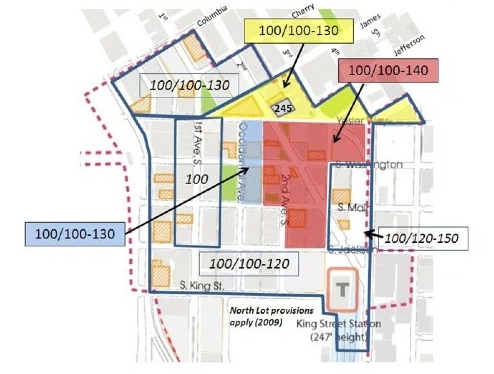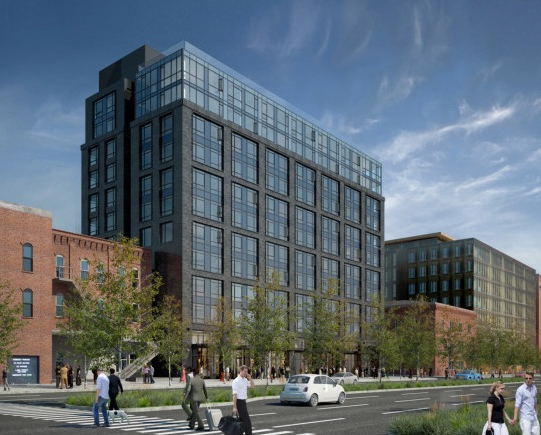In 2011, the Seattle City Council reached what was, at the time, perceived as a compromise on height limits in Pioneer Square. Councilmember Tim Burgess, who on Monday announced his retirement from the city council after becoming its elder statesman, at the time talked about a Solomonian compromise between the height limits that the Downtown Seattle Association was advocating (180 feet in areas) and the level of increase that neighborhood advocates wanted, generally speaking (none).

At the time, councilmembers like Mike O’Brien were advocating for a more conservative rezone, fearing that increases in land prices would be so high that development would be discouraged if the height limit were excessively high. It almost seems like an alternate version of Seattle, but it was just five years ago.
At the time, this was hailed as a big win for urbanists, with the door opening up to increased development in Pioneer Square, which was certainly lagging behind the boom that the rest of the city was smack in the middle of. Increased height limits, the argument went, would encourage infill development and yet Pioneer Square’s historic preservation district would maintain the existing historic buildings and keep the Square the Square.
Fast forward to 2015. Last October, we reported on a building planned for the edge of the Pioneer Square historic district, directly next to the viaduct. A developer proposed tearing down the building currently on the site, a parking garage that dates to 1919 but has been deemed a “non-contributing structure” to the historic district, and replacing it with an 11-story building, allowed under the 2011 zoning change.

The Pioneer Square Preservation Board, which must approve all new buildings in the historic district’s boundaries as this property is, rejected the building using its design guidelines: the board determined that the facade of the building was out of scale with the surrounding buildings and therefore incompatible, and that the building was not visually complementary with buildings in the immediate area, which are mostly city landmarked structures.
This presented a big question: if a landmark district board could determine that a building was out-of-scale even though it was within existing, approved zoning, would all existing landmark boards essentially be able to override City land use decisions?
Kathy Nyland, the director of the Seattle Department of Neighborhoods, apparently did not think so, and approved the project in July of last year. The Department of Neighborhoods oversees the landmark boards and their decisions, and Nyland found the proposal to be within code and district guidelines, but even still conditioned approval of the project on the addition of a four-foot setback of the top floor of the building, to allay some of concerns over scale of the building.
Following the approval by the Department of Neighborhoods, an appeal was filed by a group calling itself Save Our Square, seeking a reversal of the approval by Nyland. In January of this year, the Seattle Hearing Examiner sided with Save Our Square by finding that the section of the Seattle Municipal Code which pertains to this case is not vague, and that the building must be in scale with the surrounding structures. Now the main issue hinges on whether the Seattle Municipal Code is vague on the idea of scale in the historic districts.
The City of Seattle appealed the decision of the city hearing examiner in King County Superior Court. This week, that judge issued their ruling, once again siding with Save Our Square in determining that no, the municipal code is not vague enough to be unconstitutional. The ruling states:
SMC 23.66.140 created minimum and maximum height requirements without consideration of the tallest building on the block. Regardless of what the maximum height restriction may be, a structure must also be compatible with its surrounding structures as provided in SMC 23.66.180.
The 2011 zoning change had removed a height restriction in Pioneer Square that had previously stipulated that buildings could be no more than 15 feet higher than the next tallest building on the block. This was a concrete definition of “out of scale” but now no such concrete definition exists. In this case the idea of what is out of scale, this building specifically, has come before two judges, and both of those judges have found it out of scale. Therefore, it is less likely that the City of Seattle will spend money appealing cases like this, so the landmark board will likely be the final graveyard for a number of projects that would be allowable under current height restrictions.
The decision on this building is headed back to Kathy Nyland’s desk for reconsideration under the existing code. Whether Nyland will reject the proposal based on the landmark board’s ruling or attempt to broker the deal any further is unclear. What is clear is that the Pioneer Square landmark board’s powers are considerably more clear in instances like this.
The only solution for this would be the revision of the Seattle Municipal Code to clarify further what is and what is not to scale in Pioneer Square and other landmark districts. Until then, a parking garage sits in Pioneer Square, perfectly in proportion to the buildings surrounding it, biding its time.
The full ruling by King County superior court is below.
King County Superior Court Ruling on Pioneer Square Project – 12-12-16 by The Urbanist on Scribd
Ryan Packer has been writing for The Urbanist since 2015, and currently reports full-time as Contributing Editor. Their beats are transportation, land use, public space, traffic safety, and obscure community meetings. Packer has also reported for other regional outlets including BikePortland, Seattle Met, and PubliCola. They live in the Capitol Hill neighborhood of Seattle.

